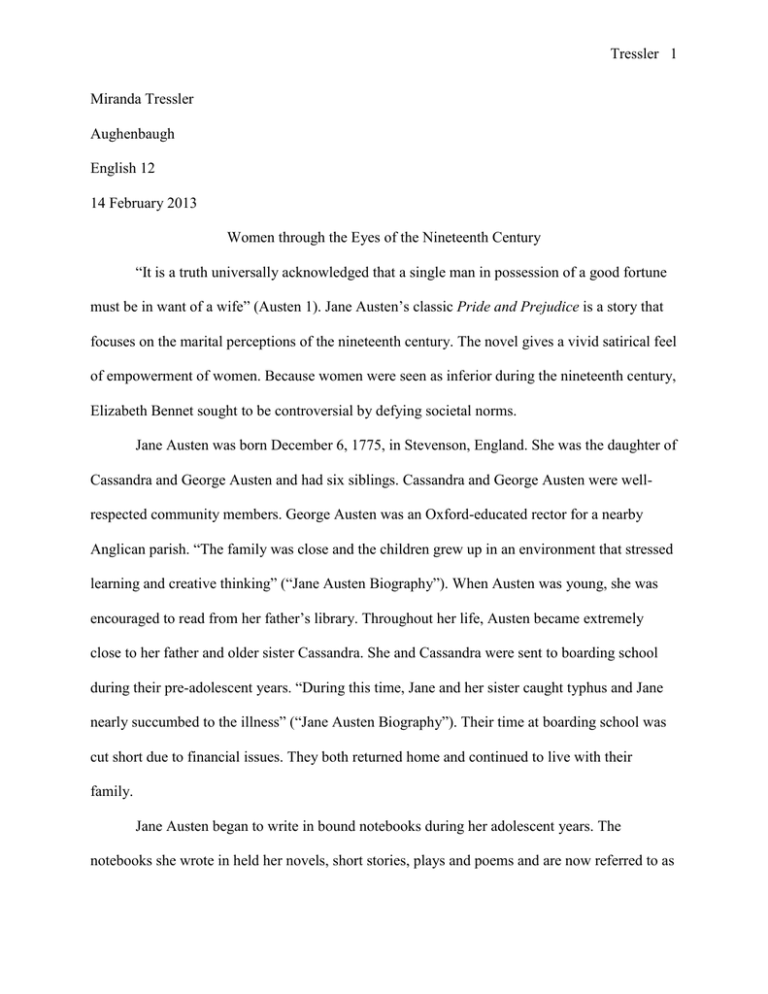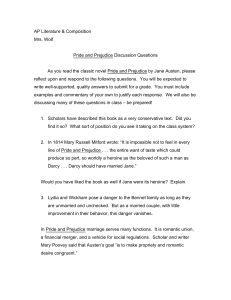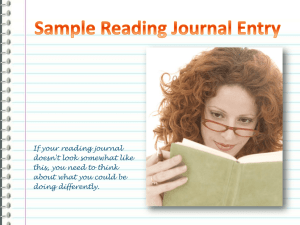File - Miranda Tressler
advertisement

Tressler 1 Miranda Tressler Aughenbaugh English 12 14 February 2013 Women through the Eyes of the Nineteenth Century “It is a truth universally acknowledged that a single man in possession of a good fortune must be in want of a wife” (Austen 1). Jane Austen’s classic Pride and Prejudice is a story that focuses on the marital perceptions of the nineteenth century. The novel gives a vivid satirical feel of empowerment of women. Because women were seen as inferior during the nineteenth century, Elizabeth Bennet sought to be controversial by defying societal norms. Jane Austen was born December 6, 1775, in Stevenson, England. She was the daughter of Cassandra and George Austen and had six siblings. Cassandra and George Austen were wellrespected community members. George Austen was an Oxford-educated rector for a nearby Anglican parish. “The family was close and the children grew up in an environment that stressed learning and creative thinking” (“Jane Austen Biography”). When Austen was young, she was encouraged to read from her father’s library. Throughout her life, Austen became extremely close to her father and older sister Cassandra. She and Cassandra were sent to boarding school during their pre-adolescent years. “During this time, Jane and her sister caught typhus and Jane nearly succumbed to the illness” (“Jane Austen Biography”). Their time at boarding school was cut short due to financial issues. They both returned home and continued to live with their family. Jane Austen began to write in bound notebooks during her adolescent years. The notebooks she wrote in held her novels, short stories, plays and poems and are now referred to as Tressler 2 Jane’s Juvenilia. Throughout her life, Austen wrote many novels such as Love and Friendship, The History of England…, Lady Susan, Elinor and Marianne, First Impressions, and Northanger Abbey. Elinor and Marianne and First Impressions were later published as the classics readers now know as Sense and Sensibility and Pride and Prejudice. “The publication of the six novels between 1811 and 1817 marked a turning point in the development of English fiction” (Southam 23). “Austen's novels also display an ambiguity about emotion and an appreciation for intelligence and natural beauty that aligns them with Romanticism” (“Pride and Prejudice”). Austen’s sister, Cassandra, also helped her illustrate The History of England…, which was a thirty-four-paged parody of historical writing. Jane Austen deceased on July 18, 1817. She died of what people believe to be Addison’s disease. “The novels were published anonymously and her authorship was revealed only after her death, through a biographical notice that came out with Northanger Abbey and Persuasions at the end of 1817” (Southam 29). It was her brother, Henry, who revealed that she was the author of the novels. Pride and Prejudice is one of the most commonly known pieces of classic literature. It is a time-honored love story about two people on opposite sides of the spectrum during nineteenth century society. The story starts out when the wealthy and single Charles Bingley arrives at the Netherfield estate. The residents of the neighborhood are pleasantly thrilled, especially Mrs. Bennet. Mrs. Bennet is the overbearing mother of the five Bennet sisters: Jane, Elizabeth, Lydia, Kitty, and Mary. She is thrilled upon Mr. Bingley’s arrival for hopes of a marriage proposal between him and one of her daughters. When the Bennet sisters all attend a local ball, they meet Mr. Bingley and are rather impressed. “They are less impressed, however, by Bingley's friend Fitzwilliam Darcy, a landowning aristocrat who is too proud to speak to any of the locals and whom Elizabeth Bennet overhears refusing to dance with her” (“Pride and Prejudice”). While at Tressler 3 the ball, Bingley and the oldest Bennet sister, Jane, forms an automatic connection and proceed to dance with one another. However, any relationship between the two would not receive the approval of Charles Bingley's sisters. His sisters did not approve for the reason of Mrs. Bennet’s lower status. “Meanwhile, Darcy finds himself attracted to Elizabeth despite his objections to her family” (“Pride and Prejudice”). Mr. Darcy is drawn to her spirited and witty personality, and Caroline Bingley's dismays about Elizabeth do not lessen how he feels. “As Darcy grows more interested in Elizabeth, Elizabeth continues to despise him and is instead attracted to George Wickham, a handsome and personable militia officer” (“Pride and Prejudice”). Elizabeth then learns that Wickham's father worked for Darcy's father and that Wickham had grown up with Darcy. “Stating that he was favored by Darcy's father, Wickham claims that Darcy disobeyed his father's bequest of a clergyman's revenue to Wickham out of selfish resentment” (“Pride and Prejudice”). Elizabeth accepts Wickham's story without question, and resents Mr. Darcy even more than she had before. Despite Jane and Elizabeth's persevering relationships, Mr. Bennet's cousin, William Collins comes to visit. Mr. Collins and is to inherit Mr. Bennet's estate when he dies. “Full of apologies for the entail and praises for his patroness, Lady Catherine De Bourgh, Mr. Collins informs the Mrs. Bennet that Lady Catherine has instructed him to marry and that he plans to choose a wife from the Bennet daughters” (“Pride and Prejudice”). After Mrs. Bennet informs him that Jane could possibly be soon engaged, he fixates his attention on Elizabeth. Mr. Collins asks for Elizabeth's hand in marriage but she quickly refuses him. He then turns to Elizabeth's best friend, Charlotte Lucas, who accepts his proposal. During the happening of these events, Jane soon receives information that Mr. Bingley has left for London unexpectedly. Caroline Bingley writes to Jane that they do not intend to return, and she predicts a match between Tressler 4 Bingley and Darcy's sister, Georgiana, who is also in London. While Jane accepts that she will never have a life without Bingley, Elizabeth becomes furious and makes the assumption that Bingley's sisters and Mr. Darcy are keeping the two apart. “Elizabeth visits Charlotte at her new home in Hunsford, Kent, and meets Mr. Collins' patroness and Darcy's aunt, Lady Catherine De Bourgh, an overbearing woman who thrives on meddling in other people's lives” (“Pride and Prejudice”). Soon after her arrival, Darcy visits his aunt with his cousin. “Darcy puzzles Elizabeth with his behavior; he seems to seek out her company, but he never says much” (“Pride and Prejudice”). Then one day, Elizabeth is surprised when Darcy proposes to her. She denies his offer, assuming that he was the cause for her sister's heartbreak and Wickham's misfortune. After returning home for a month, Elizabeth goes on a trip with her aunt and uncle Gardiner to Derbyshire county, where they visit Darcy's estate of Pemberley. There they meet Darcy unexpectedly and are all surprised at how graciously he treats them. He calls on Elizabeth at her inn, introduces her to his sister, and invites her to Pemberley for dinner. Darcy is still in love with Elizabeth, and Elizabeth begins to have similar feelings for him. (“Pride and Prejudice”) During this time, Elizabeth receives a letter from Jane telling her that Lydia and George Wickham have run off together. When Lydia is found, though, she and Wickham are married. “After the wedding, Elizabeth discovers that Darcy was instrumental in orchestrating the marriage, thereby saving the reputation and marriage ability of the other Bennet daughters” (“Pride and Prejudice”). Bingley returns to Netherfield and soon proposes marriage to Jane. Mr. Darcy then soon proposes to Elizabeth once again and she finally accepts. Tressler 5 “The rise of the novel, then, represents an expression not only of new ideologies of gender and marriage but also of universal desire explained by evolutionary psychology; nowhere can this be seen more clearly than in the most canonical of domestic novels, Jane Austen's Pride and Prejudice” (Stasio and Duncan). Women in the nineteenth century were expected to be inferior to the average male. They had hardly any rights and had to do by their husbands bidding. They had to be married by a certain age and it did not matter at what age they got married. In modern day society, this seems preposterous. “Middle class Victorian women were educated to believe that their duty was to maintain order inside the home and provide a safe haven for their husbands when they returned from the ‘real world’” (Langlinais). This theory is challenged by Austen in her novel through the character Elizabeth Bennet because she openly defies the classic expectations during this time. “In Austen, though, they do not as she creates a space that upon closer examination often empowers her female characters.” (Stasio and Duncan). While reading Pride and Prejudice, readers get the sense of female empowerment. Readers will feel as though Elizabeth does not subject to men as easily as most women during the time had. Women were expected to be virgins, wear proper clothes, play piano, draw, sew, paint, socialize, entertain, and basically be seen and not heard. “All women are brought up from the very earliest years in the belief that their ideal of character is the very opposite to that of men; not self-will and government by self-control, but submission and yielding to the control of others” (Langlinais). Elizabeth Bennet was definitely the exception to this rule. She struggled to play the piano fluently, and she stood up for herself when it came to marriage. Elizabeth, also known as Lizzy, denied Mr. Collins and Mr. Darcy her hand in marriage. Her actions would have been considered controversial to the stereotypical nineteenth century woman. “The ideal woman was to be responsible for organizing the household, bringing up the children, and providing Tressler 6 tranquility to which men returned as to a haven of peace from the turbulent world outside” (Langlinais). Caroline Bingley was a good example of this perspective. She always looked her best and she strived to be Mr. Darcy’s wife. She looked down upon Elizabeth and her family because of how they dressed and acted. “Aside from being an ideal wife and mother, the Victorian woman was expected to maintain the perfect appearance, and as a result, conduct manuals became a popular genre of literature during the Victorian era” (Langlinais). Elizabeth Bennet surely did not project this perfect image that she was to maintain. She did not care to look her best at all times or to swoon over a man. Elizabeth Bennet was most definitely the opposite of Caroline Bingley in many ways. “These various definitions of the middle class Victorian woman became the ideal representation that women were supposed to adhere to, and the Victorian heroine often represents this struggle against the idealize confinement” (Langlinais). Elizabeth Bennet rejected many laws for women during the century. As with every novel, the title always has a symbolic meaning. “It was originally titled First Impression because the appearances of the characters created the plot of the novel” (“Pride and Prejudice”). So, the title would be based off its two main characters, Fitzwilliam Darcy and Elizabeth Bennet. Elizabeth was considered full of pride. She judged Mr. Darcy right from the beginning because of his social class. She also would not allow herself to get the chance to know him either: ‘Pride,’ observed Mary, who piqued herself upon the solidity of her reflections, ‘is a very common failing, I believe. By all that I have ever read, I am convinced that it is very common indeed; that human nature is particularly prone to it, and that there are very few of us who do not cherish a feeling of self-complacency on the score of some quality or other, real or imaginary. Vanity and pride are Tressler 7 different things, though the words are often used synonymously. A person may be proud without being vain. Pride relates more to our opinion of ourselves, vanity to what we would have others think of us.’ (Austen 15) During this time period, women were to only consider the vanity aspect. They were hardly ever given the option of pride. Many women were considered superficial, based only from their appearance. Their appearance was what depicted their personality and who they were as a person. Elizabeth Bennet challenged this inkling to the point where she only considered pride. She stood up for herself in certain situations when most women would not even dare to. The perfect examples would be Elizabeth and Caroline Bingley. They were complete opposites. Caroline only wanted vanity, where Elizabeth wanted pride. Miss Bingley would be considered the ideal Victorian woman. On the other hand, men were considered to be on the opposite side of the spectrum. They were to be superior to women, and were to be the man of the household. The perfect example of the Victorian male would be Mr. Fitzwilliam Darcy. Mr. Darcy was a high class, single male whom many women sought attention from. Mr. Darcy was considered full of prejudice. He fell in love with Elizabeth when he did not expect it and when he first said that she was not the best out there. He also judged Elizabeth from the beginning based on her scarce wealth and her family. The point to the title Pride and Prejudice is that it states a narrative of the novel. Readers can get an idea of what the novel is about just from the title. Therefore, Elizabeth was not the typical nineteenth century woman. Women were expected to be inferior. A woman did not have many rights and had to do by her husband’s bidding. Women were to marry advantageously and meet the strict expectations of nineteenth century society. Because women were seen as inferior during the nineteenth century, Elizabeth Tressler 8 Bennet sought to be controversial by defying societal norms. Elizabeth Bennet defied the strict moral expectations so that she could be her own person. Jane Austen challenges the societal norms of the nineteenth century through Pride and Prejudice because she gave her women characters empowerment and control in a time period where they did not have rights to be independent. Tressler 9 Works Cited Austen, Jane. Pride and Prejudice. New York: Tom Doherty Associates, 1994. Print. “Jane Austen Biography.” Biography.com. 8 Feb. 2013. <http://www.biography.com/people/jane-austen-9192819/>. Kalil, Marie. CliffsNotes.com. 18 Feb. 2013. <http://www.cliffsnotes.com/study_guide/literature/id-147.html>. Langlinais, Chantel. “Framing the Victorian Heroine: Representations of the Ideal Woman in Art and Fiction.” Interdisciplinary Humanities 22.2 (2005): 73-93. OmniFile Full Text Mega (H.W. Wilson). Web. 5. Feb. 2013. “Pride and Prejudice.” The Literature Network. Jalic. Inc, 2012. Web. 1 Feb. 2013. <http://www.online-literature.com/austen/prideprejudice/>. Ray, Joan Klingel. “Pride and Prejudice: The Tale Told by Lady Catherine’s House.” Explicator 2008: 66+. OmniFile Full Text Mega (H.W. Wilson). Web. 1 Feb. 2013. Southam, Brian. “Jane Austen (1775-1817)” British Writers. Ed. Ian Scott-Kilvert. Vol. 1. New York: Charles Scribner’s Sons, 1997. 23-46. Print. “SparkNote on Pride and Prejudice.” SparkNotes.com. SparkNotes LLC. 2007. Web. 11 Jan. 2013. <http://www.sparknotes.com/lit/pride/>. Stasio, Michael J., and Kathryn Duncan. “An Evolutionary Approach to Jane Austen: Prehistoric Preferences in ‘Pride and Prejudice.’” Studies in the Novel 39.2 (2007): 133146. OmniFile Full Text Mega (H.W. Wilson). Web. 1 Feb. 2013.







